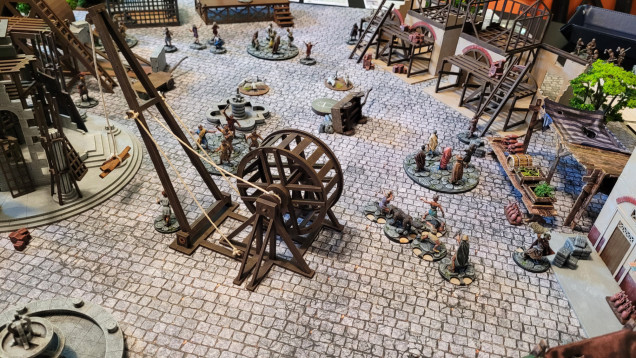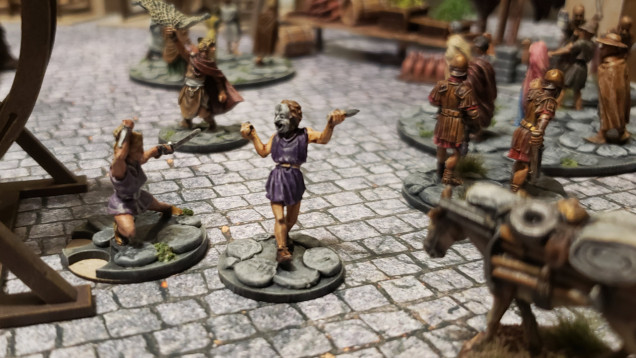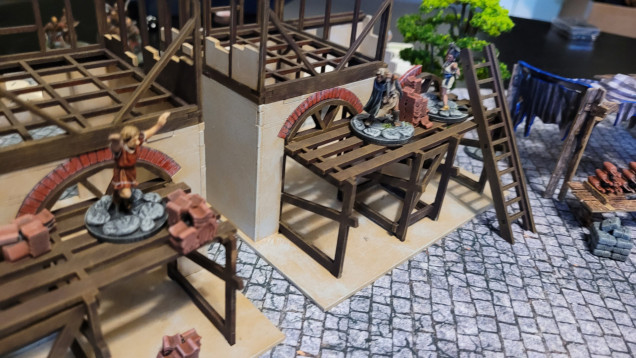
Returning to Gangs of Rome
Scenario II: Market Opportunity
We’re back after an appalling five months since our last game of Gangs of Rome. Join us as we struggle to remember how to play…
This scenario is more or less the same as the first, except that the three objective markers all start in the center of the board. The goal is still to be in possession of at least two objective tokens at the end of five rounds. Since there aren’t any new rules to learn, we took this opportunity to add two more non-player character types to the mix: the Vigiles, who function as a sort of police force, and a few Incola, individual characters who have a unique effect when a gang fighter gets near them.
We definitely went a little overboard here, with five mobs plus three Incola plus the Vigiles. The game’s token sheet only comes with six of the red mob tokens — you’re supposed to add a token for each mob, plus one for each Incola, which left us two tokens short. We were able to substitute easily enough, but in retrospect, a limit of six total mobs plus Incola seems like a good guideline to follow. The large number of NPCs made for a fairly crowded table, plus a lot of rules overhead to keep track of.
In addition to learning some new rules, we decided to take the training wheels off and put together our own gang fighter lists rather than use the starter lists from the rule book. We each took one of the Rome’s Most Wanted three-fighter gangs detailed in the book, and then filled out our lists with individual fighters. The first edition of GoR came with randomly generated stat cards for each model you bought, but that proved cumbersome (and a little expensive, I imagine) so the second edition rule book includes random tables, allowing players to accomplish much the same thing, but with a degree of wiggle room if they’re trying to generate stats for a specific figure. I converted some of my first edition cards, and randomly generated stats for some of the newer models, so we were both able to put together something close to the 200 points recommended for a regular game.
My opponent opted to use the Daughters of Sappho as her base gang, adding a selection of additional female fighters (all, coincidentally, leftovers from the first edition). I chose to counter with the Oscan Players, a new gang whose models were part of the second edition Kickstarter campaign, along with one each of the newly introduced specialist fighters: rixa (brawler), agilitas (acrobat), and furtum (thief). I’m thinking the thief in particular will be useful, with his ability to steal objectives from opposing gang fighters.
For Incola we chose the Puppeteer, the Centurion of the Vigiles, and good old Rufinus, the Scorpion Thrower. Our possibly overcrowded table made placing the mobs according to the rules (8″ away from table edges and other mobs) difficult to the point of impossible, but we did the best we could and got the game started.
The game uses a random token draw to determine turn order, with additional tokens added to the bag for the NPCs, allowing the player who draws one to move a mob or Incola in a way that will hopefully be beneficial to them. The mobs react if attacks are made to close to them, and most of the Incola effects depend on proximity as well, so it’s sometimes possible to turn them to your advantage, or at least get them out of your way.
In round one I managed to rush to the center and grab two of the objectives, while my opponent ran afoul of the Scorpion Thrower — Rufinus throws scorpions at any mob or gang fighter that moves within 6″ of him. Unfortunately he didn’t last long, as he got too close to an angry mob who didn’t appreciate having scorpions thrown at them and got trampled to death.
The Puppeteer managed to get a few early jabs in. Any gang fighter within 4″ of him gets insulted by his puppet, reducing their attack or defense stats for their next activation. When my opponent got an opportunity to move him, the Puppeteer ran and hid behind some market stalls, where he remained for much of the game.
In round two, my acrobat who managed to snatch one of the objectives retreated to a construction scaffolding where we got to explore one more rules addition: the ability to throw items such as roof shingles or clay pots at opposing gang fighters. My opponent had one of her fighters pursue to a nearby scaffolding, where we proceeded to throw roof tiles at each other. The rules for this are very straightforward, with proximity to a piece of scatter terrain conferring the ability to make a ranged attack. Since the game allows for counterattacks and we were both standing next to piles of roof tiles, we ended up with quite the flurry of construction material.
I tried really hard to get my thief into position to steal one of my opponent’s objectives. He got into base contact, but failed on the steal action, allowing my opponent’s gang fighter to wallop him. Meanwhile, my opponent smacked down my other objective carrier and was able to grab a second objective, then retreated most of her models to her side of the board. I gave chase, and in round three my thief finally managed to earn his pay and grab another objective. Meanwhile my acrobat, still holding an objective, retreated to my end of the board to pick slivers of roof tile out of his hair.
We misread and/or forgot some of the rules governing the Vigiles, so they didn’t make an appearance until round three. The Vigiles are two models on a single 40mm base, who begin play off the board. At the start of the game a disturbance counter is set for a d6 plus the number of rounds in the game (in this case five) — we started with the disturbance counter at 8. Every time any mob reacts to a gang fighter attack, or is forced to react by a player moving them, the disturbance counts down 1. When it gets to zero, the Vigiles appear, adjacent to the mob that triggered them, and them move to attack the nearest gang fighter.
Of all the NPCs, the Vigiles have the most rules overhead. You need to remember to count down their timer, but also, once they are in play they react any time a mob reacts to gang fighter activity within their line of sight. Their larger bases can sometimes make it difficult for them to get to their targets, which is thematic of guards fighting their way through a crowd but also required a fair amount of consensus when determining their targets.
By round four we had quite the scrum going, with my brawler fighting it out with Urganalla, one of my opponent’s Daughters of Sappho. They were backed into a corner and surrounded by an angry mob and two sets of Vigiles all baying for their blood. Plus a dog (the Fierce Mastiff from GoR first edition who I recreated as a regular gang fighter). There was a lot of back and forth but in the end my opponent held on to the objective.
With all the re-learning we had to do, we ran out of time and decided to call the game at the end of round four. Honestly we couldn’t really see how anything that might happen in a fifth round would change things, as Urganalla had my brawler on the ropes, and each of us had managed to move one of the other two objectives out of reach. The game was great fun though, although as mentioned earlier we definitely tried to pile too much optional stuff on for what was only our second-ever game. Lessons learned for next time: stick to six or fewer NPCs (incola, mobs and Vigiles combined), start the game a little earlier in the day, and try not to wait five months between games…
We’ll be back for Scenario III: Bounty, hopefully sooner rather than later.































![TerrainFest 2024 Begins! Build Terrain With OnTableTop & Win A £300 Prize! [Extended!]](https://images.beastsofwar.com/2024/10/TerrainFEST-2024-Social-Media-Post-Square-225-127.jpg)















































Nice write ups. Just recently bought the rules for this. What mat have you used. It looks quite nice.
Thanks! The mat is vinyl and comes from Mats By Mars, a US-based company. I’ve got several of their mats, the quality has always been good.